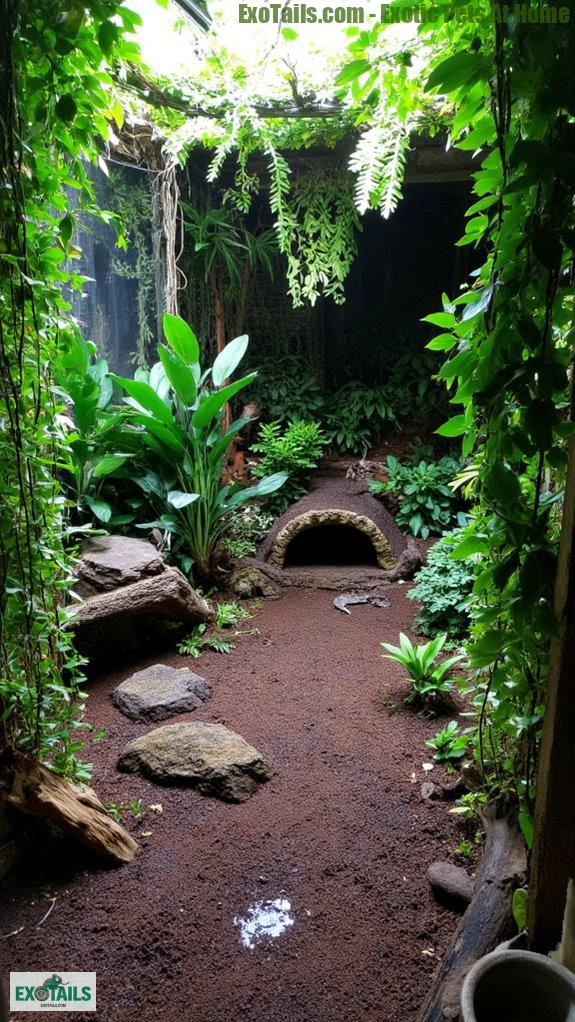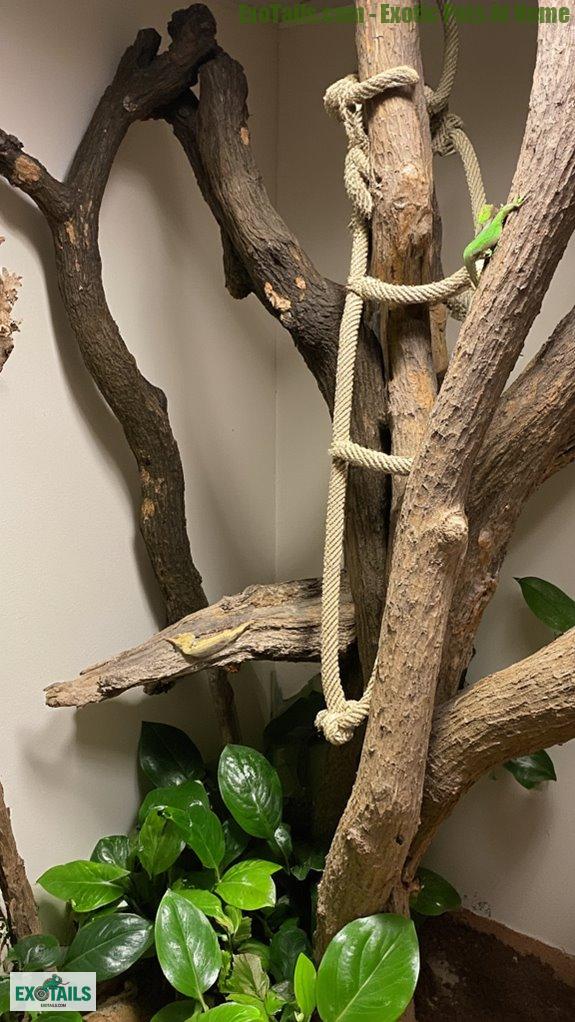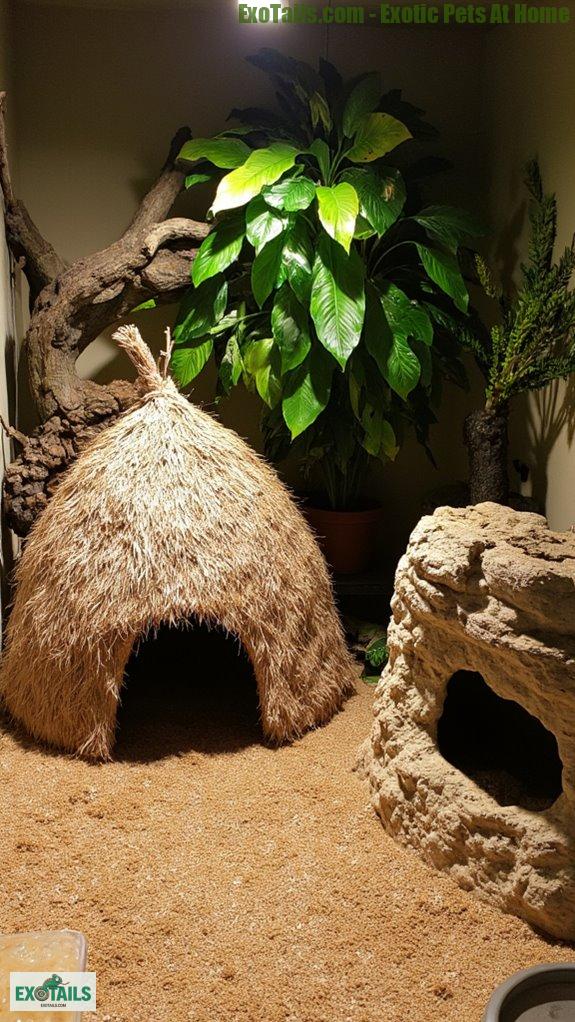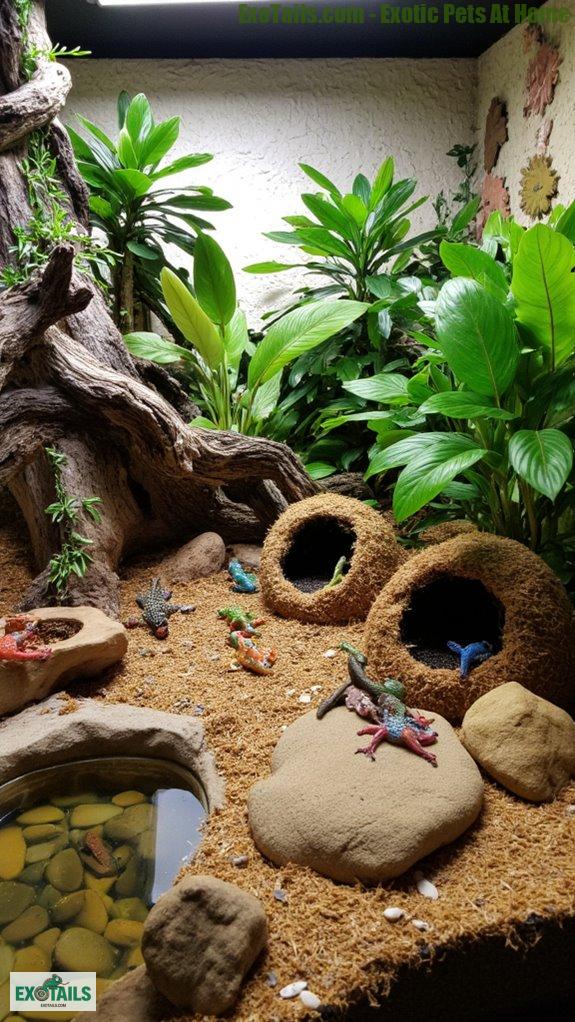7 Best Enrichment Ideas for Reptile Rooms
To create a blissful paradise for your reptiles, try these seven enrichment ideas! First, build naturalistic habitats with live plants and bioactive substrates. Next, incorporate climbing structures for adventurous escapades, and don’t forget those cozy hiding spots like coconut huts and rock caves! Adding environmental enrichment keeps things exciting, while proper temperature and humidity control guarantees their comfort. Finally, set up engaging feeding stations. Intrigued? There’s so much more to discover in this vibrant world of reptile care!
Quick Takeaways
- Incorporate climbing structures like branches and vines to maximize vertical space and encourage adventurous behavior in reptiles.
- Install various hiding spots, such as coconut huts and rock caves, to provide security and comfort for reptiles.
- Use bioactive substrates with live plants to enhance air purification and create a vibrant ecosystem for reptiles.
- Offer environmental enrichment through varied textures and scents, promoting mental stimulation and engagement for reptiles.
- Maintain proper temperature gradients and humidity levels to ensure a comfortable and healthy living environment for reptiles.
Naturalistic Habitats

Creating naturalistic habitats for reptiles is a delightful adventure that can transform your space into a mini ecosystem.
With a comfy bioactive substrate, you’ll create an ideal environment, nurturing both your reptiles and the live plants that enhance their surroundings.
The plants not only purify the air but also provide hiding spots and grazing options—why wouldn’t you want your little scaly friend to have a five-star retreat?
At ExoTails, I’ve combined my love for exotic pets and home decor to help others craft these vibrant havens.
Incorporating bioactive systems into your enclosure enhances the health and wellbeing of both your reptiles and their plant companions.
Ready to turn your room into a reptile paradise? Let’s get planting!
Climbing Structures

While you might think that reptiles are perfectly content lounging around on the ground, they actually thrive when given the chance to climb and explore.
Adding climbing structures maximizes vertical space in your reptile room and can mirror a natural habitat. Think sturdy branches, textured vines, or even rope ladders!
Maximize vertical space in your reptile room with climbing structures like branches and vines for a natural habitat experience!
Let’s face it, if I wanted to spend my life flat on the ground, I’d choose a nice carpet. But your reptiles deserve adventure!
With ample climbing materials, you’ll see their confidence soar, and honestly, who doesn’t love a good lizard circus? Additionally, providing climbing options can help create essential temperature gradients in their environment, mimicking natural conditions.
Trust me, investing in these setups is the way to go!
Hiding Spots

Just envision how cozy a reptile would feel when they’ve a little hideaway to call their own! Hiding spots are essential for their well-being, and I love providing them with secure fixtures that make them feel safe.
Here are some great hiding materials to reflect on:
- Coconut huts—who doesn’t want a tropical escape?
- Rock caves—nature’s very own fort!
- Plastic hide boxes—simple, effective, and easy to clean!
- Live plants—because nature knows best.
Creating the perfect reptile room is what inspired me to launch ExoTails. Additionally, incorporating natural hiding spots can help mimic their wild habitats and enhance their overall stress levels.
Reinventing their world can be just as fun for you as it’s for them!
Environmental Enrichment

When you think about your reptiles’ happiness, environmental enrichment plays a huge role in making their space feel like a thriving habitat instead of a barren box.
Imagine how they thrive with sensory stimulation like different textures, temperatures, or smells!
Social interactions can also make a significant difference.
I love observing my reptiles react to changes; it’s like they’re telling me how much they appreciate their environment.
I created ExoTails because I believe every reptilian friend deserves this level of attention.
Interactive Decor

Interactive decor can truly transform your reptiles’ habitat into a lively and dynamic space!
Creating an engaging environment helps stimulate your scaly friends, and I’m all about making things exciting at ExoTails.
Enhancing your reptiles’ habitat sparks their curiosity and excitement, turning every moment into a thrilling adventure!
Here are some fun ideas to reflect on:
- Colorful decor: Bright plants or faux coral can make everything pop.
- Thematic elements: Try a jungle or desert theme for adventure.
- Moveable structures: Incorporate rocks or logs that your reptiles can explore.
- Sensory objects: Include mirrors or textured surfaces for exploration.
With these, your reptiles won’t just live; they’ll thrive, making every day an adventure!
Temperature and Humidity Control

Maintaining the right temperature and humidity in your reptile room isn’t just a nice touch; it’s absolutely essential for your scaly pals’ health and happiness!
Ever think about how your reptiles might feel, lounging in a too-cool corner? For ideal health, you need temperature gradients—that cozy basking spot and a cooler retreat.
And don’t forget humidity regulation! Too dry, and they might as well be in the desert.
As someone who’s navigated the wild world of exotic pets, I get it. Creating ExoTails was my way of sharing knowledge, so let’s keep your reptiles comfy and thriving together, shall we?
Feeding Stations

Setting up feeding stations in your reptile room isn’t just about plopping down some bowls and hoping for the best; it’s a little art and a lot of science!
Here are some solid feeding techniques that I always use to enhance food diversity:
- Choose the Right Bowls – Deep ones for messy eaters, shallow ones for picky ones.
- Location, Location, Location – Place them in low-stress zones for your pets.
- Rotate Foods – Keep meals exciting and nutritious.
- Monitor Feeding Times – Create a schedule for consistency.
Trust me, you’ll love how it levels up your reptile’s meal experience!
Create Naturalistic Habitats

After you’ve set up those stellar feeding stations, it’s time to think about the space where your reptiles live. Creating naturalistic habitats is essential, and I love using natural materials for that authentic touch. Biotope design works wonders to mimic their natural environment, keeping your scaly friends happy.
Here’s a quick guide to get you started:
| Element | Purpose | Natural Materials |
|---|---|---|
| Plants | Hiding spots & climbing | Live or silk plants |
| Substrate | Natural feel | Coconut fiber or moss |
| Decor | Enrichment & shelter | Rocks, driftwood, branches |
Let’s make their mini-oasis a reality!
Questions and Answers
How Often Should I Change the Decor in My Reptile Room?
I thought keeping decor static would be boring, yet I realized how essential aesthetic changes are. I refresh my reptile room’s decor every few months, ensuring a vibrant environment that sparks my controlled excitement for it.
What Materials Are Safe for Reptile Room Decor?
When considering safe materials for decor options in my reptile room, I prioritize non-toxic woods, natural stones, and durable plastics. I always double-check labels to verify everything’s safe for my scaly friends.
Can I Use Live Plants in My Reptile Room?
Absolutely, I’d love to share! Live plants transform the habitat like a jungle explosion, offering incredible benefits. They enhance humidity, purify air, and create hiding spots—so yes, let those greens thrive in your reptile room!
Is UVB Lighting Necessary for All Reptiles?
I believe UVB lighting is vital for many reptile species. It’s important for their calcium metabolism and overall health. Understanding each reptile’s requirements helps guarantee I provide the right environment for my pets to thrive.
How Do I Introduce New Items to My Reptile’s Habitat?
When I introduce new items to my reptile’s habitat, I take time for gradual habitat adjustments. I observe their behavioral responses, ensuring they adapt comfortably and feel secure, ultimately enhancing their environment and well-being.







